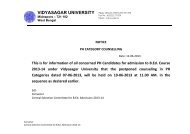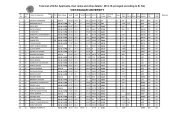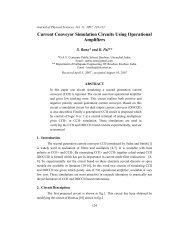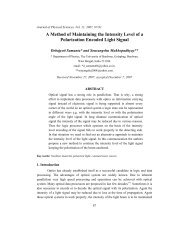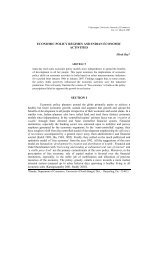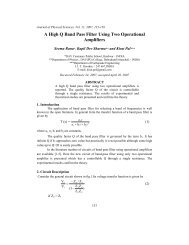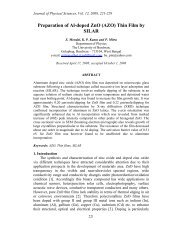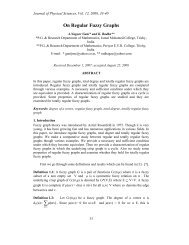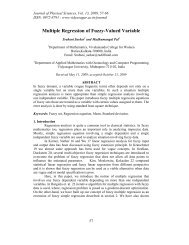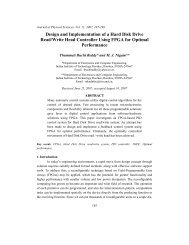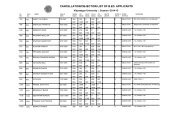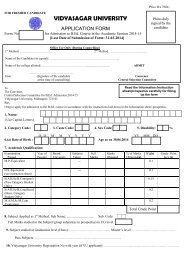VIDYASAGAR UNIVERSITY JOURNAL OF COMMERCE
VIDYASAGAR UNIVERSITY JOURNAL OF COMMERCE
VIDYASAGAR UNIVERSITY JOURNAL OF COMMERCE
Create successful ePaper yourself
Turn your PDF publications into a flip-book with our unique Google optimized e-Paper software.
Arindam Gupta, Debashis Kundu<br />
other conventional performance measures which may help to measure the change in MVA.<br />
The importance of non-market linked variables like total capital employed, yield, return on<br />
net worth, etc. first on EVA and then on relative profitability have also been examined into<br />
to find out the relative impact of these variables over economic profit and profitability<br />
respectively.<br />
Literature Survey<br />
There are a large number of studies concerning shareholder value creation. But for the<br />
purpose of this paper, only those articles focusing on the application of new market-oriented<br />
techniques to generate shareholder wealth have been looked into.<br />
Kohli and Chawla (2006) have used the concepts of burden, spread, apart from some<br />
selected ratios to study the trends in profitability of selected Indian banks. While income,<br />
spread and net profit grew for all the banks, the private sector banks reported diminishing<br />
burden but increasing spread and non-interest income as compared to the public sector<br />
banks.<br />
The study conducted by Stewart (1991) on the statistical association between MVA and<br />
EVA was based on a sample of 613 US companies over the period from 1984 to 1985 in<br />
relation to the period from 1987 to 1988. The author reports strong positive relation between<br />
the average standardized values of EVA and MVA. However the results do not seem to<br />
support the relation between negative EVA and negative MVA.<br />
O’Byrne (1996) regresses firm value on EVA and earnings measured in the form of NOPAT<br />
(net operating profit after tax). The study considers a total of 6651 firm-years over the period<br />
from 1985 to 1993. Two types of regressions are used where the market value divided by the<br />
capital is the dependent variable. After a series of adjustments to the EVA regression, the<br />
author reports the robustness of EVA in explaining firm values.<br />
Grant (1996) identifies the ‘wealth-creators’ and the ‘wealth-destroyers’ among a set of<br />
firms with the help of EVA/Capital employed and MVA/Capital employed measurements.<br />
The findings indicate that the ratio, EVA/Capital employed can explain approximately 32%<br />
of the variation in MVA/Capital employed.<br />
Dodd and Chen (1996) in their paper have studied the correlation between stock returns and<br />
EVA, residual income, RoA, RoE and EPS. It is based on a sample of 566 US companies<br />
over the period from 1983 to 1992. The adjusted EVA was found to offer few advantages<br />
over unadjusted EVA or residual income. The incremental tests also suggested that the<br />
components of EVA only add marginal information to earnings. The results hence do not<br />
support the notion that EVA dominates earnings in relative information content.<br />
A case study on the relative statistical significance of market capitalization and EVA as an<br />
effective valuation tool conducted by Chattopadhyay and Gupta (2001) found that EVA<br />
did not prove to be a better tool than the traditional measure like market capitalization. The<br />
study used correlation analysis, Runs test and simple regression on EVA and market<br />
capitalization of Hindustan Lever Limited over a nine-year period from 1991 to 1999.<br />
In another Indian study, Prakash Singh (2005) first tests the robustness of the new tools of<br />
shareholder wealth measurement – EVA and MVA. He then goes on to test the efficacy of<br />
Vidyasagar University Journal of Commerce 69



